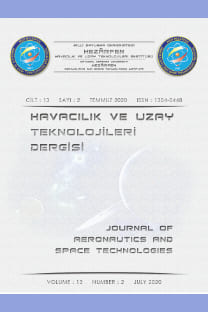Türbülanslı Akışlar İçin Sonlu Hacimler Yöntemi Tabanlı Bir LES Çözücüsü
A Finite Volume Based LES Solver for Turbulent Flows
___
- [1] G. Lacaze ve J. C. Oefelein, "Development of quality assessment techniques for large eddy simulation of propulsion and power systems in complex geometries", Sandia National Laboratories, Albuquerque, 2015.
- [2] N. Gourdain, L. Gicquel, M. Montagnac, O. Vermorel, M. Gazaix, G. Staffelbach, M. Garcia, J.-F. Boussuge ve T. Poinsot, High performance parallel computing of flows in complex geometries: I. Methods, Computational Science & Discovery 2, 015003 (2009).
- [3] S. K. Robinson, Coherent motions in the turbulent boundary layer, Annual Review of Fluid Mechanics 23, 601-639 (1991).
- [4] L. S. Langston, M. L. Nice ve R. M. Hooper, Three-dimensional flow within a turbine cascade passage, Journal of Engineering for Power 99(1), 21-28 (1977).
- [5] J. Smagorinsky, General circulation experiments with the primitive equations, Monthly Weather Review 91(3), 99-164 (1963).
- [6] P. A. T. Cocks, M. C. Soteriou ve V. Sankaran, Impact of numerics on the predictive capabilities of reacting flow LES, Combustion and Flame 162, 3394-3411 (2015).
- [7] A. Vire, D. Krasnov, T. Boeck ve B. Knaepen, Modeling and discretization errors in large eddy simulations of hydrodynamic and magnetohydrodynamic channel flows, Journal of Computational Physics 230, 1903-1922 (2011).
- [8] D. T. Karahan, A New Large Eddy Simulation for Wall-Bounded Turbulent Flows, Istanbul Technical University, MSc Thesis, Istanbul, 2017.
- [9] S. Er, A Finite Volume Based In-House Large Eddy Simulation Solver For Turbulent Flows In Complex Geometries, Istanbul Technical University, MSc Thesis, Istanbul, 2019.
- [10] G. Karypis ve V. Kumar, A fast and high quality multilevel scheme for partitioning irregular graphs, SIAM Journal on Scientific Computing 20(1), 359-392 (1998).
- [11] N. Andersson, L.-E. Eriksson ve L. Davidson, Large-eddy simulation of subsonic turbulent jets and their radiated sound, AIAA Journal 43(9), 1899-1912 (2005).
- [12] G. Erlebacher, M. Y. Hussaini, C. G. Speziale ve T. A. Zang, Toward the large-eddy simulation of compressible turbulent flows, Journal of Fluid Mechanics 238, 155-185, 1992.
- [13] F. Nicoud ve F. Ducros, Subgrid-scale stress modelling based on the square of the velocitygradient tensor, Flow, Turbulence and Combustion 62(3), 183-200 (1999).
- [14] V. K. Chakravarthy ve S. Menon, Subgrid modeling of turbulent premixed flames in the flamelet regime, Flow, Turbulence and Combustion 65(2), 133-161 (2001).
- [15] J. Lowe, A. Probst, T. Knopp ve R. Kessler, Low-dissipation low-dispersion second-order scheme for unstructured finite volume flow solvers, AIAA Journal 54(10), 2961-2971 (2016).
- [16] J. Blazek, Computational Fluid Dynamics: Principles and Applications, Elsevier, 2005.
- [17] A. Jameson, W. Schmidt ve E. Turkel, "Numerical solutions of the Euler equations by finite volume methods using Runge-Kutta time-stepping schemes", AIAA 14th Fluid and Plasma Dynamics Conference, Palo Alto, 1981.
- [18] R. von Kaenel, Large-eddy simulation of compressible flows using the finite-volume method, Swiss Federal Institute of Tenhnology Zurich, PhD Thesis, Zurich, 2003.
- [19] E. Garnier, M. Mossi, P. Sagaut, P. Comte ve M. Deville, On the use of shock-capturing schemes for large-eddy simulation, Journal of Computational Physics 153, 173-311, (1999).
- [20] National Center for High Performance Computing;, "Technical Specifications of Sariyer Server," [Online]. Available: https://en.uhem.itu.edu.tr/donanim.html. [Accessed: 27 07 2022].
- [21] R. Bouffanais, M. O. Deville ve E. Leriche, Large-eddy simulation of the flow in a lid-driven cubical cavity, Physics of Fluids 19, 055108 (2007).
- [22] A. K. Prasad ve J. R. Koseff, Reynolds number and end-wall effects on a lid-driven cavity flow, Physics of Fluids A 1, 208–218 .(1989).
- [23] P. N. Shankar ve M. D. Deshpande, Fluid mechanics in the driven cavity, Annual Review of Fluid Mechanics 32, 93–136 (2000).
- [24] E. Leriche ve S. Gavrilakis, Direct numerical simulation of the flow in a lid-driven cubical cavity, Physics of Fluids 12, 1363–1376 (2000).
- [25] P. Moin ve K. Mahesh, Direct numerical simulation: A tool in turbulence research, Annual Review of Fluid Mechanics 30, 359-378 (1998).
- [26] N. Ben-Cheikh, F. Hammami, A. Campo ve B. Ben-Beya, A dynamic sub-grid scale model for large eddy simulation of turbulent flows in a lid-driven cubical cavity, Comptes Rendus - Mecanique 340(10), 721-730 (2012).
- [27] L. S. Langston, M. L. Nice ve R. M. Hooper, Three-dimensional flow within a turbine cascade passage, Journal of Engineering for Power 99(1), 21-28 (1977).
- [28] R. D. Stieger ve H. P. Hoodson, The transition mechanism of highly loaded low-pressure turbine blades, Journal of Turbomachinery 126(4), 536-543 (2004).
- [29] J. G. Wissink ve W. Rodi, «Direct numerical simulations of transitional flow in turbomachinery,» Journal of Turbomachinery, 128(4), pp. 668-678, 2006.
- [30] R. G. Sandberg, R. Pichler ve L. Chen, "Assessing the sensitivity of turbine cascade flow to inflow disturbances using direct numerical simulation", 13th International Symposium for Unsteady Aerodynamics, Aeroacoustics and Aeroelasticity in Turbomachinery (ISUAAAT), Tokyo, 2012.
- [31] S. Sarkar, Influence of wake structure on unsteady flow in a low pressure turbine blade passage, Journal of Turbomachinery 131(4), 041016 (2009).
- [32] P. Stadtmuller ve L. Fottner, "A test case for the numerical investigation of wake passing effects on a highly loaded LP turbine cascade blade", ASME Turbo Expo 2001: Power for Land, Sea, and Air, New Orleans, 2001.
- ISSN: 1304-0448
- Yayın Aralığı: 1
- Başlangıç: 2003
- Yayıncı: Dr. Öğr. Üyesi Fatma Kutlu Gündoğdu
Reşat Buğra ERKARTAL, Ömer ÇETİN, Atınç YILMAZ
Ay Albedosu Etkisinde Güneş’e Yönelme Vektörü Kestirimi
Emre ALPMAN, Barış BİÇER, Levent A. KAVURMACIOĞLU, Seher EKEN, Harun İNCİ, Zeliha ÇAMUR
Üç Boyutlu Belirsiz Dil Değişkenlerine Dayalı Türkiye Uzay Limanı Yer Seçimi
Melike İLHAN, Fatma KUTLU GÜNDOĞDU
Cengiz HACIZADE, Hasan KINATAŞ
Bir İnsansız Hava Aracı Pervanesi İçin Açık Kaynaklı Bir Aerodinamik Şekil Optimizasyon Uygulaması
Şahin YİĞİT, Saleh ABUHANIEH, Barış BİÇER
Türbülanslı Akışlar İçin Sonlu Hacimler Yöntemi Tabanlı Bir LES Çözücüsü
